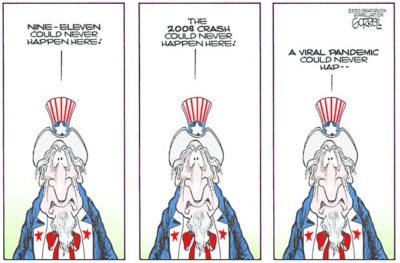A dispute is brewing about debt, deficit, and disease. Government spending has inflicted a multi-trillion dollar deficit in America. Recent reports are projecting the single year federal budget deficit will swell to nearly $4 trillion.
Related: Accurate Coronavirus Antibody Test Approved
This should be making lawmakers and citizens alike wary of more spending. So far, all it seems to have done is to enlarge the government’s appetite for needlessly suppressing our civil liberties.
The argument goes there is a global demand for safe-haven assets. They say it has driven interest rates on U.S. debt to near zero. But if that is true: Why have we now held Treasury auctions where the only buyer was the Federal Reserve?
Common sense should be telling us debt larger than the whole economy is unsustainable. Interest rates will not remain at zero. When they go up the interest payments alone will become unsustainable.
While all politicians agreed the coronavirus appropriations to this point were necessary, that does not mean the deficit is not a significant issue. Deficits for 2020 were pushing $1 trillion before the coronavirus.
There is a fight coming. On one side will be those who fear what happens if we spend too much. On the other side will be those panicked by the Great Recession. They are afraid of what might happen if we don’t spend enough.
The simple truth is the coronavirus has become a spending orgy. The federal government is spending trillions of dollars. Some is going into fighting the disease. Much is current period spending in fear of the effects of a politically induced economic shutdown. Those are the excuses for why ending civil liberties running up large bills are good things.
The Committee for a Responsible Federal Budget (CFRB) projects the deficit will exceed $3.8 trillion this year. Three-quarters of the 2020 deficit is crisis rationalized. CRFB points the one-year deficit is 15% – 20% of pre-coronavirus GDP. This is a deficit unheard of outside of World War II. The coronavirus is being used to rationalize this as an appropriate use of borrowing.
Our appetite for unlimited spending has to be curtailed and the sooner the better. We haven’t had any discussion about adding $2.7 trillion to the national debt. Having that amount of debt will drag on the economy for decades and threaten our national future. There are real risks that come with a high deficit and debt. Chief among them is higher interest rates and spiraling inflation.
Inflation and rising interest rates can and will emerge from unchecked spending. Before moving further we ought to see what’s working and what’s not. The government spending will have a tremendous impact. But government spending can never be a substitute for a functioning economy. Funding for the government must come from the private sector economy.
Trump is calling for an added $2 trillion in debt-funded infrastructure. He cites historically low-interest rates as justification. This is the bait in the trap. But the President is not alone. The chairman of the Federal Reserve has committed to aggressively purchasing government debt through the declared emergency. He is also privately pressuring lawmakers to be equally aggressive.
Sen. Hawley is floating a stimulus plan that sees the government picking up most of America’s payrolls. The proposal is pure nonsense. It will dwarf all the appropriations made by Congress so far. Debt, deficit, and disease; legislating fantasy fixes none of these things.
Little caution is being used around the nation’s capital. Lawmakers were eager to spend during good times following the tax cuts. Now, they seem to have no respect for the restrictions debt imposes. We have not had a budget for more than two decades. They took away from the Great Recession a sense the government can do anything, at any time. It just ain’t so. We are out of other people’s money.
During the Great Recession, an aging population and the global economy kept interest rates low. That experience cannot be relied upon for repetition. It did allow the government to take on a level of debt similar to the deficits incurred during the current emergency declaration.
We got lucky to not have to face rising interest rates or inflation. Maybe this explains why some lawmakers are more open to aggressive spending. But the change in lawmakers’ attitude is not a good thing.
Fiscal responsibility matters. But we have reached a point where America may be unable to tackle its pre-coronavirus debt load. America can no longer do without a growing economy. At this point, the concern being expressed is about putting more burden on the future.
But perhaps we get more bang for our buck in solving the economic crisis we have right now. That may create a stronger economy… maybe one able to pay back the debt. That seems a long shot. If the economy is weak even maintaining the debt we had before is going to be more difficult. That’s the commonsense position.
There a case for the government not taking its foot off the fiscal gas prematurely. But sustaining high levels of debt comes with risks. It definitely means higher government interest costs, lower levels of private sector investment, and a future of less growth.
Borrowing may be necessary right now. Maybe it is staving off a depression. But it’s not free, it’s not costless. And we are getting deeper into the debt trap by the minute… The truth is you can pay me now or you can pay me later… but you are going to pay. Debt, deficit, and disease need not be the three horsemen of the apocalypse… unless we insist.
